DATASET_STYLE
Weiyue Liu1, Zhongyi Hua2, Tong Zhou3
Last compiled on 01 September, 2025
DATASET_STYLE.RmdIntroduction
The function of the DATASET_STYLE template is to adjust
the style of branches at any level. It includes two subclasses: branch
and label. The function parameter is simple, whereas the input data is
more complex. The DATASET_STYLE template belongs to the
“Style” class (refer to the Class for detail
information).
Typically, users define a branch or node style by entering the branch or node name, subclass function name, action location, color, font or line style, and size. The selected branch will be displayed in new style changes specified by the sub function. This function has a high level of integration, and its data parameters are relatively complex, posing a great challenge to users.
Adjust style
This section uses dataset 1 as an example to show how to adjust the styles. (refer to the Dataset for detail information)
Load data
The first step is to load the newick format tree file
tree_of_itol_templates.tree and its corresponding metadata
df_frequence.
library(itol.toolkit)
tree <- system.file("extdata",
"tree_of_itol_templates.tree",
package = "itol.toolkit")
data("template_groups")
df_data <- data.frame(id = unique(template_groups$group),
data = unique(template_groups$group))We can use the branch subtype function to adjust the color of the entire branch area. In E012, we only used two columns of information to implement the function. For other data, subtype information is passed through the “subtype” parameter, position information is passed by the “position” parameter, line thickness is passed by the “size_factor” parameter. When the line type is not explicitly defined, the default is normal line type. Also, colors are generated from the second column of input data as they are not explicitly specified. If the input data contains all six columns of data, the program will also automatically determine which column is subtype, which is color, and so on. In addition, colors can also be defined through the “color” parameter. Therefore, for various possible situations, the program has automated processing methods, reducing the threshold for users to prepare to input data.
unit_12 <- create_unit(data = df_data,
key = "E012_style_1",
type = "DATASET_STYLE",
subtype = "branch",
position = "clade",
size_factor = 5,
tree = tree)
write_unit(unit_12)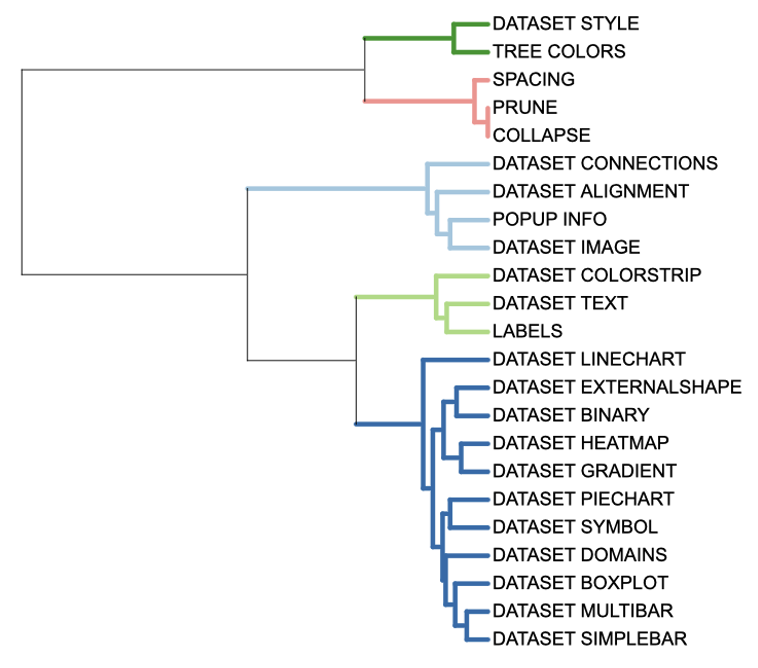
Dataset style visualization example 1
We can use the “branch” subtype function to adjust the color of the node area. In E013, we only used two columns of information to implement the function. There is no location defined here, and the program defaults to the node location. Other parameters are consistent with E012. If you simplify it further, when the line thickness is 1, the size parameter can also be omitted and not written.
unit_13 <- create_unit(data = df_data,
key = "E013_style_2",
type = "DATASET_STYLE",
subtype = "branch",
size_factor = 5,
tree = tree)
write_unit(unit_13)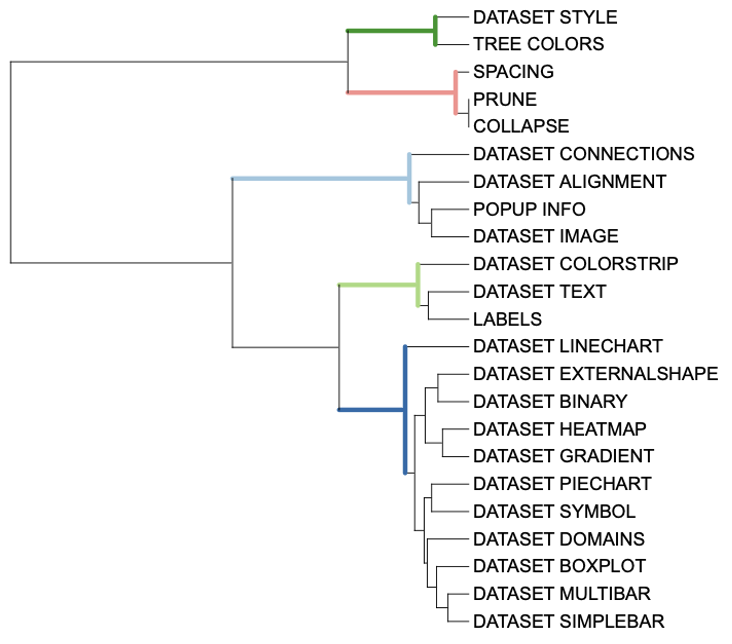
Dataset style visualization example 2
We can use the label subtype function to adjust the color of the labels to which the node area belongs. In E014, we only used 2 columns of information to adjust the style of some labels. Note that if the active location is a node area, the id column of the label subtype function can only use branch ids, which is a limitation imposed by iTOL itself.
unit_14 <- create_unit(data = template_groups[1:10,],
key = "E014_style_3",
type = "DATASET_STYLE",
subtype = "label",
position = "node",
size_factor = 1.5,
tree = tree)
write_unit(unit_14)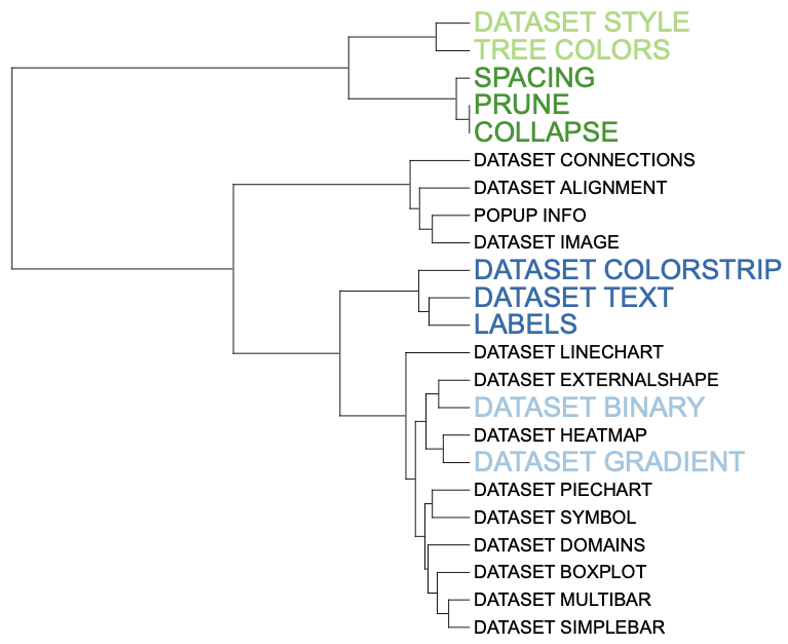
Dataset style visualization example 3
We can use the label subtype function to adjust the color of the
labels to which the branch area belongs. In E015, we only used 2 columns
of information to adjust the style of all labels. For functions that
cannot be implemented by E014, it is necessary to define the position as
the entire branch in DATASET_STYLE in order to use the node
id to control large area labels.
unit_15 <- create_unit(data = df_data,
key = "E015_style_4",
type = "DATASET_STYLE",
subtype = "label",
position = "clade",
size_factor = 1.5,
tree = tree)
write_unit(unit_15)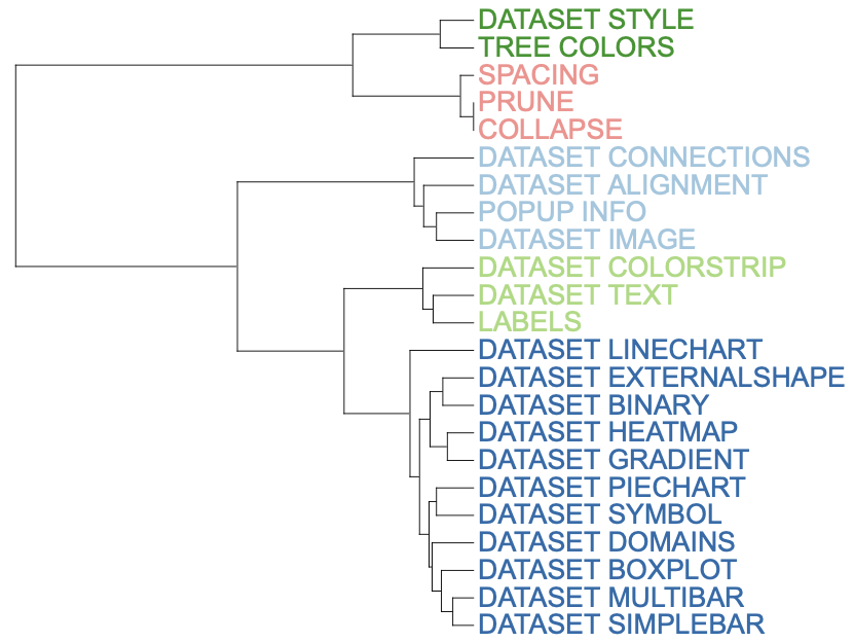
Dataset style visualization example 4
We can use the label subtype function to simultaneously adjust the color of the labels and backgrounds to which the branch area belongs. In E016, we only used 2 columns of information to adjust the style of all labels and backgrounds.
unit_16 <- create_unit(data = df_data,
key = "E016_style_5",
type = "DATASET_STYLE",
subtype = "label",
position = "clade",
size_factor = 1.5,
font_type = "bold-italic",
background_color = "#000000",
tree = tree)
write_unit(unit_16)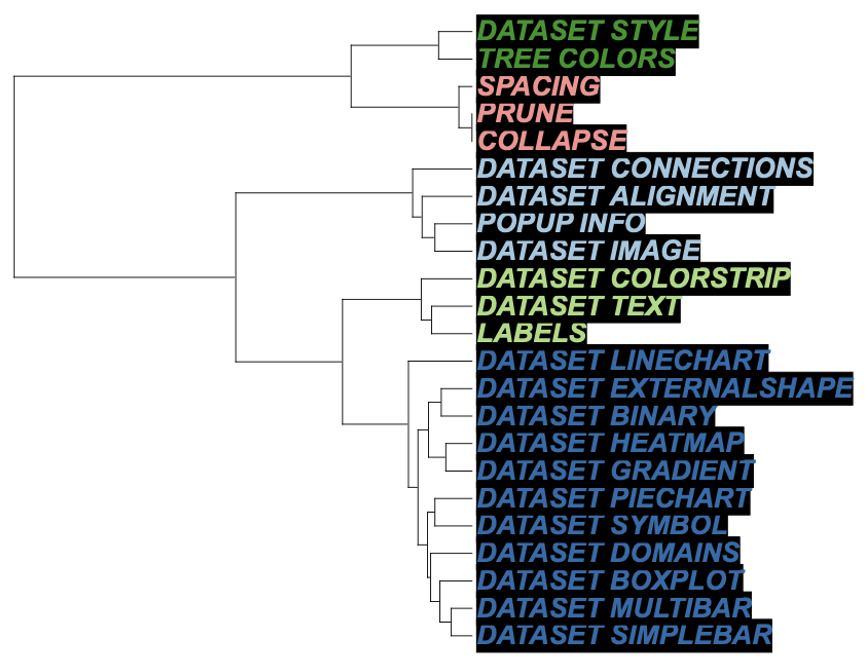
Dataset style visualization example 5
In all template functions, TREE_COLORS is one of the
most commonly used functions, and it is strongly recommended that users
master it. Using itol.toolkit allows users to easily
implement complex functions and data preparation.DATASET_STYLE is an improved version of
TREE_COLORS, splitting the original 5 subtypes into
positional parameters, but there is a significant overlap between the
two functions. Also, DATASET_STYLE drops the common
function of range subtype, which limits its application scenario.
Moreover, DATASET_STYLE templates may overwrite previous
settings, while TREE_COLORS can achieve an overlay effect.
In addition, the input data of up to 6 columns pose challenge for users,
so the use of this template function is not ideal. It is recommended
that users master TREE_COLORS.